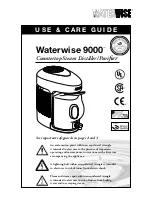
3.12 Operational And Checkout Procedures
3.13 Maintenance
The circuit from R to Y is also completed, energizing the compressor
contactor of the outdoor unit. The contactor will close and start the
compressor and condenser fan motor.
Cooling (heat pump)
Constant torque version – When the thermostat calls for cooling, the
circuit from R to G is completed. The blower motor is energized
directly by the 24VAC signal from the thermostat.
The circuit from R to Y is also completed, energizing the compressor
contactor of the outdoor unit. The contactor will close and start the
compressor and condenser fan motor.
Circuit R to O energizes the reversing valve to the cooling position.
Heating (heat pump)
Constant torque version – When the thermostat calls for heating, the
circuit from R to G is completed and the blower motor is energized
directly by the 24VAC signal from the thermostat.
The circuit from R to Y is also completed, energizing the compressor
contactor of the outdoor unit. The contactor will close and start the
compressor and condenser fan motor.
In the heating mode, the reversing valve of the outdoor unit is not
energized.
If the indoor temperature continues to fall, the R to W circuit is
completed, energizing the electric heat contactor(s).
Heating (electric heat only)
Note: The thermostat must be setup to bring the blower on when the
electric heat is energized.
Constant torque version - When the thermostat calls for heating, the
circuit from R to G is completed and the blower motor is energized
directly by the 24VAC signal from the thermostat. The circuit from R
to W is completed energizing the heating contactor(s).
To obtain proper performance, all units must be operated and charge
adjustments made in accordance with procedures found in the
Service Facts document of the outdoor unit.
After installation has been completed, it is recommended that the
entire system be checked against the following list:
[ ] 1. Be sure unit suspension (if used) is secure and there are no
tools or loose debris in, around or on top of the unit.
[ ] 2. Properly insulate suction lines and fittings.
[ ] 3. Properly secure and isolate all refrigerant lines.
[ ] 4. Verify that all electrical connections are tight.
[ ] 5. Check all duct outlets; they must be open and unrestricted.
[ ] 6. Check drain lines and be sure all joints are tight.
[ ] 7. Be sure the return air filter is installed.
[ ] 8. Operate complete system in each mode to verify proper
performance. Verify operation of supplementary electric heater.
Defrost
Supplemental heat during defrost can be provided by connecting the
X2 (black) wire from the outdoor unit to W1 at the indoor unit. This
will prevent cold air from being discharged from the indoor unit
during defrost.
Low voltage control wiring should be 18 Awg, color coded (105
degree C minimum). For lengths longer than 100ft., 16 Awg wire
should be used. Make certain that separation of control wiring and
power wiring has been maintained.
The system air filter(s) should be inspected, cleaned or replaced at
least monthly. Make certain that the access panels are replaced and
secured properly before placing the unit back in operation. This
product is designed for dependable service; however, periodic
maintenance should be scheduled and conducted by trained
professional service personnel. This service should be conducted at
least annually, and should include testing and inspection of electrical
and refrigerant components. The heat transfer surface should be
cleaned. The blower motor is permanently lubricated for normal
operating conditions.
Section 4. Wiring
R
G
C
W1
R
B
O
Y
X2
R
G
B/C
O
Y
W
HEAT PUMP SYSTEMS
Brown
24 VAC HOT
FAN
24 VAC
Common
SOV
COOL/HEAT
1st STAGE
HEATING
2nd STAGE
Thermostat
Air Handler Outdoor
Unit
Black
White
White
AC SYSTEMS
R
G
C
W1
B
Y
R
G
B/C
Y
W
Brown
24 VAC HOT
FAN
24 VAC
Common
COOLING
HEAT
Thermostat
Air Handler Outdoor
Unit
3.11 Sequence of Operation
Cooling (cooling only)
Constant torque version – When the thermostat calls for cooling, the
circuit from R to G is completed. The blower motor is energized
directly by the 24VAC signal from the thermostat.
7































